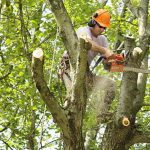Even if your garden has its fair share of trees, it’s always sad to see one of them go. While such projects make us feel low-spirited, tree cutting is often inevitable. It’s often seen in the context of cutting one tree to save many. Or to save the home.
Taking such a decision is as hard as actually realizing it’s time to say goodbye to a tree. It’s always best to take the advice of a local tree company to see if all other options are exhausted before you decide to cut a tree. But when tree trimming and pruning and fertilizing and all other remedies cannot do the trick, it’s time to take the step. So, when tree cutting becomes a must? Let us examine these cases.
When trees are diseased
Trees get sick, too. Pest infestation is a common problem, although diseases vary from one location to the next and between tree types. Many diseases are caused by fungi and the consequences are plenty – premature defoliation, discolored leaves, fungal growth on roots, cracks and dents, weak branches, just to name a few of the signs indicating tree sickness.
Now, the major problem with tree diseases is that the signs are not noticed in time. When the disease cannot be remedied, the tree is slowly dying. Before this happens, the danger lies on the possibility of the sick tree affecting the other trees around it. Diseases may easily spread, seriously affecting all trees in the adjacent area and then, you won’t have one tree to cut but, perhaps, all of them. When trees are sick, cutting them becomes a must.
When trees die
At one point, trees let go. They die. They die if their disease is not treated in time and also due to stress caused by pollution, the weather, soil erosion. Don’t forget that trees are living organisms, which grow – going through various stages of growth, and while their span varies – based on the tree and location, their life is interrupted when photosynthesis is interrupted too – they don’t get the right nutrients, water, sunlight.
Now, when trees die, they become weak. Simply put, they may fall during a storm. They cannot withstand any kind of force or extra weight. And so, trees may collapse due to storms, winds, snow. The problem here is obvious. When trees collapse, they may fall on people, homes, cars and so, they become a liability. Consequently, tree removal becomes a must.
When trees become a liability
Trees may become a liability even before they die. Yes, sure, when they die, they have no control and may collapse at any moment onto anything. But oftentimes, such dangers are present when the trees are damaged, too. How can trees be severely damaged to the point that should be cut? When they are injured by a lightning strike, a fire, vehicles, animals. Sometimes, the damage is immediately apparent. Sometimes, it takes years to show.
Now, when trees are damaged, they are also weakened. In some extreme cases, they may still fall. In other cases, their branches may easily fall, creating safety concerns.
And there’s more. Trees may become a liability when they are planted closed to the home. Or, vice versa, when the home is built close to trees. The tree’s roots, which grow underground, eventually become huge as they spread, compromising the foundations of the home – hence, the structural integrity and by extension, the family’s safety. In such cases, trees are cut and must be cut to avoid the inevitable.

